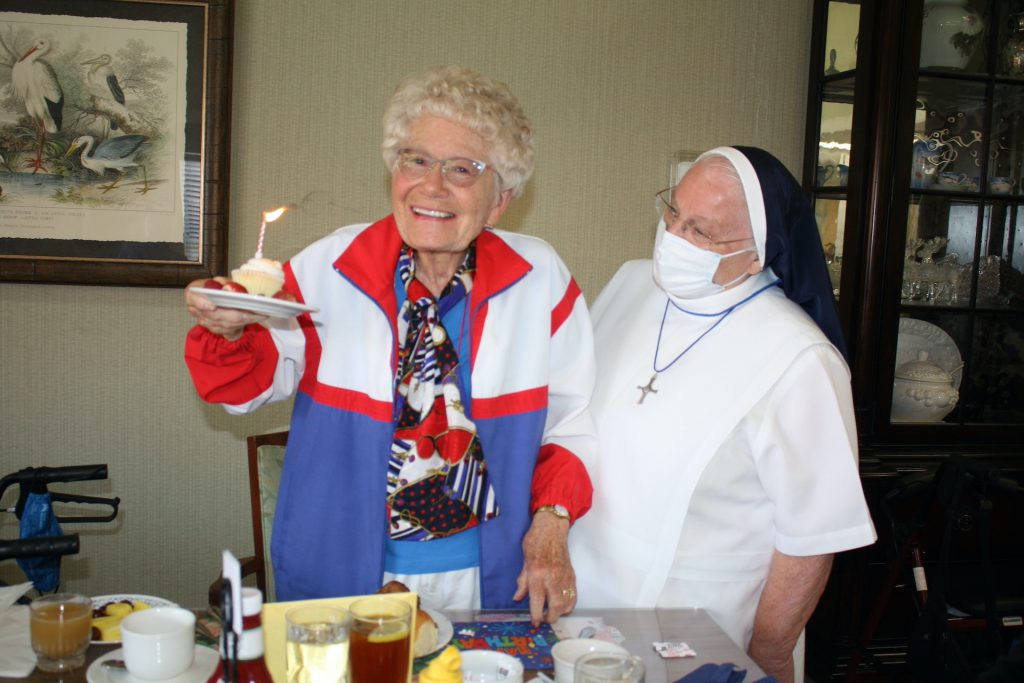By Lola Sherman
SAN DIEGO — “Jesus is here.”
That’s how Sister Rose Hoye sums up what makes Nazareth House different from other assisted-living facilities.
That difference lifted its residents in the last year as they lived dark days of isolation and fear as the coronavirus cut through society, several residents and staff members said.
Sister Rose, as she is known, is the American Superior of the worldwide Congregation of the Sisters of Nazareth, which founded Nazareth House in San Diego nearly a century ago. Today, she leads the six Nazareth sisters who live in the complex that overlooks historic Mission San Diego de Alcalá.
“We provide service for the entire person — soul and body,” she said. “It’s absolutely faith-based. It’s the core of who we are. What else would sustain us but prayer (during the pandemic)?”
In mid-June, 80 residents lived at the Catholic facility, which offers various levels of care and health-related support, including independent, assisted living and hospice and palliative care.
Four centenarians live at the house, with two residents being 103 years old. Most residents are in their eighties. One resident has lived at the facility for 11 years.
It’s clear the house is a place of faith even from the parking lot, which has bright-white statuary of the Holy Family greeting visitors.
An especially wide corridor gives the house an open feeling, and small hand-painted murals along the walls provide a mission-like setting — as does the central courtyard for sitting or meandering. Every resident’s room opens to a garden.
There’s a chapel, with its stained-glass windows, where Mass is celebrated daily. Bishop Robert McElroy celebrates Mass there frequently, and Auxiliary Bishop John Dolan does so once a week.
Several retired priests and religious women also are residents at Nazareth House. One of them is Father Michael Ortiz, a retired Army chaplain who also served parishes in the diocese. He volunteered to celebrate Mass four times a week at the House.
Another resident is Rita Houser, who moved into the care home from Banning, in Riverside County, just as the pandemic erupted. She was buoyed by the faith that it was able to maintain for all its people, she said.
COVID-19 disproportionately hit long-term care facilities, and Nazareth House was no exception. But as the pandemic is easing, and most residents are fully vaccinated, friends and family members can now visit the residents, with some restrictions.
The facility is taking applications once more and its staff is giving in-person tours to prospective families. Rates at the House are comparable to other assisted-living facilities.
Barbara Anne Crowley, chief executive officer for the Nazareth Houses in America, said a “great faith-based” employee core helped the house weather the pandemic.
Crowley has been with Nazareth Houses for 33 years – first as a volunteer, then a caregiver, then a registered nurse.
“I gradually worked my way up the ladder” to become CEO two years ago, she said.
The greatest change, she said, has been in the growth of the “servant leadership” of the 85 employees. Most are long-term, she said, with very little turnover.
Father Ortiz remembered when, long before he was a resident, the care home was staffed primarily by the sisters. Similar to what has happened in Catholic schools, lay personnel now are in the majority.
Nazareth House does, in fact, run a school as well – the adjacent Nazareth School. Some 317 children are enrolled in pre-kindergarten through 8th grade. It’s the only school operated by the congregation in the U.S.
Established in 1924, the house represented the foothold of the Sisters of Nazareth in America and started out as an orphanage.
The congregation was founded by a French nun, Victorie Larmenier, after she immigrated to England in 1851. The sisters also own Nazareth Houses throughout the United Kingdom, Ireland, Australia, New Zealand and Africa. There is a total of 39.
Three of them are in the U.S., in San Diego, Los Angeles and Fresno. One in San Rafael had to close earlier this year, Crowley said, because of finances — it couldn’t enroll new residents during the pandemic, and housing in the area is too expensive for its employees.
Father Ortiz has remodeled his independent unit, he said, by adding a Murphy bed, so it can serve as a bedroom at night and an office in the daytime. He is the author of a couple of books, including “Green Beret Chaplain,” of his experiences in Vietnam. He also was a chaplain at Cathedral Catholic High School for four years.
He said he checked out other assisted-living homes when his nephews insisted he no longer live in his condo after he had fallen and lain unconscious all day.
Others might seem cheaper, he said, but they aren’t when you factor in they don’t offer laundry services or medication assistance and charge additional fees.
“Common sense tells me this is about the best place,” he said. “I’m very happy now. The biggie is that it’s a Catholic place.”
More information about Nazareth House is available by phone at (619) 563-0480, email at info@nazarethhousesd.org, and on its website.
Lola Sherman is a freelance journalist based in Oceanside.






